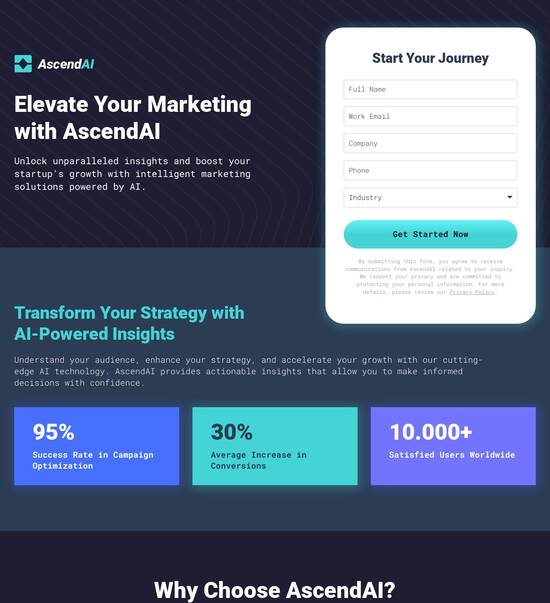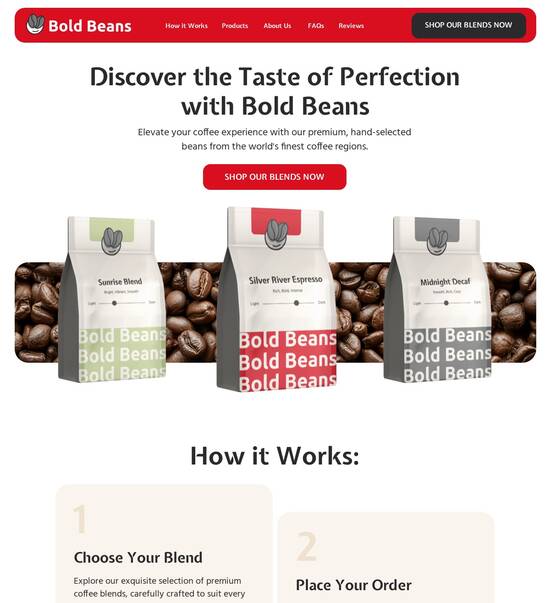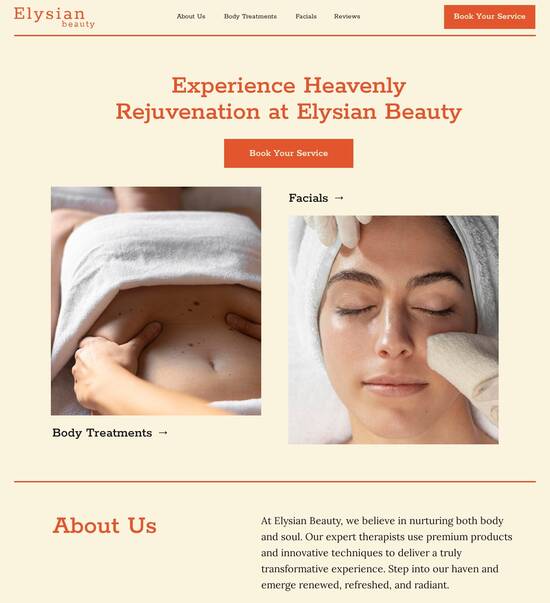
Product page template for FMCG companies
Explore Similar TemplatesAbout template
Reach out to the right audience with product page template for FMCG companies
Recommended templates

Easy to build without coding
With the intuitive drag-and-drop builder, anyone on your team can create high-converting pages without any knowledge of code or design. Make enhancements to your landing page with custom widgets using Javascript, HTML/CSS, or third-party scripts.

Multiple layouts for any industry and goal
Select from 500+ landing page layouts built to boost conversions across industry-specific scenarios. Customize them by adjusting fonts, adding images, and generating on-brand content with the AI assistant. Quickly scale with Instablocks® and Global Blocks that you can save, reuse, and update globally.

Loads fast and looks polished on any device
Every template is responsive, which means they present professionally on any device and load blazingly fast with our Thor Render Engine. You can also power them up with Google AMP technology to deliver an unparalleled mobile experience and drive higher conversions.

Robust analytics & experimentation
Get real-time updates and reporting across all your devices, showing the number of visitors, conversions, cost-per-visitor, and cost-per-lead. Launch AI-powered experiments, run A/B tests, and use heatmaps to analyze user behavior, then optimize your landing page to maximize conversions.







Easy to build without coding
With the intuitive drag-and-drop builder, anyone on your team can create high-converting pages without any knowledge of code or design. Make enhancements to your landing page with custom widgets using Javascript, HTML/CSS, or third-party scripts.
Multiple layouts for any industry and goal
Select from 500+ landing page layouts built to boost conversions across industry-specific scenarios. Customize them by adjusting fonts, adding images, and generating on-brand content with the AI assistant. Quickly scale with Instablocks® and Global Blocks that you can save, reuse, and update globally.
Loads fast and looks polished on any device
Every template is responsive, which means they present professionally on any device and load blazingly fast with our Thor Render Engine.
Robust analytics & experimentation
Get real-time updates and reporting across all your devices, showing the number of visitors, conversions, cost-per-visitor, and cost-per-lead. Launch AI-powered experiments, run A/B tests, and use heatmaps to analyze user behavior, then optimize your landing page to maximize conversions.
All the features you need to build lead-generating landing pages
Explore more featuresLearn how to build top-performing landing pages for any goal
FAQs
Leading the way in building high-performing landing pages





A powerful landing page and CRO platform for marketers
In today's competitive digital landscape, marketers must leverage effective tools to drive successful campaigns. Instapage stands out as a premier landing page and CRO platform that not only simplifies page creation but also enhances conversion rates. This guide will walk you through the essential steps to maximize your marketing impact using Instapage's robust features.
Understanding Instapage's capabilities
Instapage is designed for marketers from various sectors such as marketing and advertising, technology, and financial services. With its user-friendly interface, marketers can create responsive landing pages that resonate with their target audience. In addition, the platform offers a treasure trove of templates tailored to various campaigns, ensuring that users can start strong.
- 100+ customizable templates: Start your project without the hassle of creating a page from scratch. Choose from high-converting designs suitable for any campaign.
- Analytics dashboard: Get insights into your page performance with detailed analytics that illustrate engagement, traffic sources, and conversion rates.
- AdMaps for personalized experiences: Align ad campaigns with relevant landing pages to ensure cohesive and optimized user journeys.
Creating landing pages with ease
To ensure effective page creation, marketers can utilize Instapage's flexible tools. Start by selecting a template that aligns with your campaign objectives.
Optimizing for conversions
It's not enough to just create landing pages - optimization is key to driving better results. Here are some methods to enhance conversions:
- A/B testing: Tailor your messaging and layouts to different audience segments to see what resonates most, refining your approach over time.
- Heatmaps: Visual insights into user behavior on your page allow for informed adjustments that can lead to higher engagement and conversion rates.
- Dynamic text replacement: Customize messages based on the source of traffic or audience segment to provide a tailored experience.
Ensuring collaboration and efficiency
With Instapage, collaboration among teams is seamless, allowing for quick feedback loops and real-time edits.
- Instant feedback: Share drafts with stakeholders to receive timely insights, speeding up the review process.
- Real-time editing: Make changes collaboratively, reducing the need for back-and-forth emails.
- Secure sharing: Provide access to external partners without compromising sensitive information.
By leveraging these strategies, your marketing campaigns can become more effective and tailored to your target audience. Instapage empowers you to take control of your landing page strategy and maximize your ROI.
Ready to transform your digital marketing campaigns? Start using Instapage today to explore its innovative features and watch your conversion rates soar.
People also ask about Product page template for FMCG companies
The strategic imperative of product page templates in FMCG
Understanding the FMCG landscape
Fast-Moving Consumer Goods (FMCG) represent a crucial segment of the global market, comprised of products that sell quickly at relatively low cost. Examples include food, beverages, toiletries, and over-the-counter drugs. The significance of FMCG lies not only in sales volume but also in consumer interactions, which heavily influence purchasing decisions. Companies competing in this space must demonstrate agility and innovation, especially in crafting compelling digital experiences.
Consumer behavior is fundamental to FMCG success. Recent trends indicate that shoppers are increasingly seeking convenience and online accessibility. For instance, a notable inclination towards mobile shopping has been observed, with consumers using smartphones more than ever to research products before making purchases. Therefore, understanding these behavior patterns is essential for FMCG companies to devise strategies that resonate with contemporary shopping preferences.
Increased importance of sustainability in purchasing decisions.
Growing reliance on online reviews and peer recommendations.
Expectations for fast and reliable shipping options.
Given the intense competition within the FMCG sector, brands are drawn to innovative strategies that capture customer attention. This competitive landscape necessitates that brands not only focus on product quality but also invest in their digital presence, ensuring that product page templates are optimized for engagement and conversion.
The role of digital interfaces in FMCG
A seamless online experience is now paramount for FMCG companies. Digital domains act as a storefront, where first impressions can determine consumer trust and overall sales performance. By leveraging product page templates that load quickly and provide essential information at a glance, companies can enhance user engagement and foster loyalty. The transition to online shopping highlights the need for intuitive navigation and clear visual hierarchies.
Consumer expectations are continually evolving, driven by advancements in technology and shifts in shopping behavior. Shoppers anticipate detailed product information at their fingertips, alongside high-quality images and seamless browsing experiences. This demand underscores the relevance of employing well-designed product page templates that meet and exceed these expectations, ultimately leading to improved customer satisfaction.
Crafting the perfect product page template
When developing a product page template for FMCG companies, certain core components are essential to ensure effectiveness. Visual appeal is paramount. Studies show high-quality images and engaging graphics can significantly boost conversion rates. For added interactivity, utilizing Javascript to incorporate dynamic elements can produce an engaging user experience that keeps consumers on the page longer.
High-resolution images that showcase the product from various angles.
Videos demonstrating product use can enhance consumer understanding.
Clear call-to-action buttons that are strategically placed within the page.
Alongside visuals, compelling product descriptions are vital. These should focus on storytelling that resonates with the target audience, highlighting key benefits, features, and use cases. Effective product descriptions are often optimized with relevant keywords to enhance search engine visibility and drive organic traffic. The ability to communicate the unique selling propositions of products can greatly influence purchasing decisions.
Essential features to incorporate
In addition to core components, certain essential features should be present in product page templates to enhance the user experience. First, navigation and responsiveness across devices is important to ensure that users can easily access information, regardless of whether they are using a smartphone, tablet, or computer. A sensible layout adapts to different screens, reducing potential frustration and encouraging continued engagement.
Another crucial feature is the incorporation of interactive elements. User interactivity can be enhanced by properly placed buttons for purchasing or learning more, as well as sliders for product comparisons. Enabling customer reviews and ratings fosters trust and establishes authenticity, as consumers often rely on peer feedback when making decisions. Real-time stock availability and pricing information serve as vital indicators of reliability and transparency, encouraging prompt purchasing.
Enhancing user experience with effective design
To achieve an effective product page template, attention should be paid to layout and structure principles. Best practices for organizing information are critical. By employing categories and subcategories for intuitive browsing, companies can guide users effectively through their product offerings. Leveraging tools like Gantt charts can be useful in showcasing product timelines, while flowcharts can enhance navigation paths, making the selection process more transparent.
Clear categories for categorizing products and improving discoverability.
Easy-to-use filters that help customers sort based on preferences.
Responsive design that adapts to various screen sizes.
Aligning product page strategies with budget considerations is an often-overlooked aspect. Marketing teams should ensure that their page designs not only meet aesthetic standards but also align with cost management goals. This involves maintaining a balance between investments in sophisticated technology and maintaining operational costs while achieving optimal functionality of the product pages.
Integration with backend systems
Linking product page designs with backend systems is crucial for maintaining updated and accurate information. This includes connecting product visibility with sales data, thereby enabling dashboard management that reflects real-time performance metrics. Depending on technology and platform, this can enhance overall workflow through streamlined operations, ensuring that product pages remain current with consumer demand.
Additionally, automating updates around stock levels and pricing can lead to an improved consumer experience. When customers see the accurate availability of products and their prices as they navigate, it fosters trust and encourages transactions. Automated processes not only enhance user satisfaction but also reduce the burden on staff to manually update product information.
Advanced features to transform product pages
Data-driven decision-making can vastly improve FMCG companies' marketing strategies. By utilizing analytics, brands can track user interactions on their product pages, including conversion rates and engagement levels. This data provides insights that inform optimization strategies. For instance, if a particular product page is not performing as expected, analysis can reveal why, allowing for targeted adjustments to drive improvements.
An A/B testing framework to compare multiple versions of a product page.
Heatmaps showcasing user behavior to understand click-through patterns.
Mechanisms to gather consumer feedback directly through product pages.
Incorporating a consumer feedback loop is essential for continuous improvement. Gathering insights through reviews not only allows companies to adapt their pages accordingly but also builds community around the products. A responsive approach to feedback can illustrate a company’s commitment to customer satisfaction, enhancing brand reputation.
Case studies in FMCG product page success
Highlighting industry leaders provides essential insight into effective product page strategies. Many successful FMCG companies have adopted sophisticated templates that focus on both functionality and aesthetics. For instance, Company X implemented an innovative product page template featuring dynamic images, thorough descriptions, and engaging customer reviews, resulting in a measurable increase in both conversion rates and average order value.
Analyzing these case studies reveals a clear correlation between the quality of product page design and sales performance. Brands that prioritize user experience by incorporating well-structured layouts and essential features tend to thrive in a competitive marketplace. Observing their methodologies can serve as a blueprint for other FMCG companies aiming to enhance their online presence.
Crafting strategic proposals and business models
Aligning product pages with overarching strategic goals is crucial for FMCG brands aiming for growth. A comprehensive marketing plan should incorporate these templates, highlighting their role in attracting and retaining consumers. Teams must be educated on best practices relative to maintaining high-quality product pages, ensuring consistency in branding and customer engagement efforts throughout.
Internally pitching ideas for improvements necessitates preparation of persuasive presentations. Mockup development paired with regular feedback sessions fosters collaborative discussions, ensuring that all stakeholders are aligned on the design direction and overall strategy. Involving diverse teams creates buy-in and promotes a unified effort toward enhancing product pages.
Measuring the success of your product page template
Establishing key performance indicators (KPIs) is essential for evaluating the effectiveness of product page templates. Tracking conversion rates offers direct insight into page performance, while monitoring user experience metrics such as site engagement and bounce rates can provide more comprehensive insights into consumer behavior. Together, these metrics allow companies to gauge which elements of their pages perform well, and which need refinements.
Average session duration as a metric for user engagement.
Bounce rate indicating potential issues with user experience.
Rate of cart abandonment providing insight into the checkout process.
Ongoing optimization strategies are critical for maintaining an edge in the FMCG market. Utilizing A/B testing can lead to continuous improvements, as brands can identify what resonates best with consumers, allowing for iterative adjustments. Furthermore, staying adaptive to industry changes fosters resilience; FMCG brands that can pivot strategies based on shifting market dynamics are better positioned for future success.
Future trends in FMCG product pages
Emerging technologies such as artificial intelligence and machine learning are expected to play a significant role in personalizing user experiences on product pages. Brands will increasingly employ AI-driven recommendations based on previous shopping behaviors, allowing for tailored offerings that enhance the likelihood of conversion. This level of personalization can create a sense of connection between the brand and consumer, ultimately fostering loyalty.
Sustainability practices are also coming to the forefront in influencing consumer choices. As eco-conscious consumers grow in number, FMCG companies must prioritize sustainability not only in product development but also in how products are presented online. Prioritizing sustainable practices in product page design can reflect a brand’s commitment to social responsibility, thereby appealing to an ever-important segment of the consumer base.
Summary of key takeaways
In summary, effective product page templates are pivotal in enabling FMCG companies to enhance their digital presence, capture consumer interest, and increase sales. By focusing on key components like visual appeal, strong product descriptions, essential interactive features, and backend integrations, brands can significantly improve user experience. As consumer expectations evolve within the digital landscape, companies must adopt innovative and strategic approaches to keep pace.
Encouraging experimentation and the adoption of cutting-edge tools and strategies is vital for brands looking to lead in the FMCG sector. Future-facing approaches that integrate technological advancements will allow companies to craft resonant and effective product pages, positioning them for success in a competitive marketplace.
Envisioning the future of FMCG product pages
The road ahead suggests that FMCG brands will need to adopt agile methodologies in digital marketing. Predictions indicate that as technology evolves, so too will consumer expectations and behaviors. Companies must remain dynamic, learning and adapting to these changes swiftly. With advancements in user experience design and a focus on integrating sustainability and technology, the future of FMCG product pages looks promising.
Brands that prioritize innovation, integrate user feedback, leverage analytics, and embrace emerging trends will not only stay relevant but also thrive in a rapidly changing landscape. The lasting impact of effective product page templates will reshape the FMCG market, fueling competition and enhancing consumer engagement.
Ready to skyrocket conversions?
Supercharge your ad campaigns with high-performing landing pages
Get started














